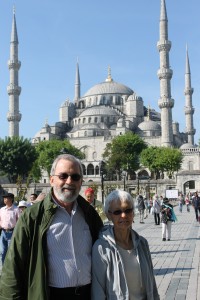Istanbul
Friday, May 16th, 2014City of minarets, narrow streets, and good food. These are our impressions of Old Istanbul. We visited the two most famous mosques—Blue Mosque and Hagia Sophia—as well as a smaller mosque.
Sultanahmet Cami (Blue Mosque) was built in early 1600’s with 6 minarets and wonderful symmetry of design. It is commonly referred to as the Blue Mosque because of its over 20,000 small blue tiles forming geometric and floral designs. It is beautiful.
Unfortunately, thousands of other tourists think so too. Even though it is a “working” mosque it was hard to feel the reverence we usually feel in a religious building. We also visited a much smaller working mosque—Rusten Pasha Mosque. This also has beautiful blue tiles and a much more reverent feel.
Several old remains stand in the Hippodrome near the Blue Mosque. One is the Obelisk of Theodosius brought from Luxor, Egypt in 390 A.D. The hieroglyphics and carvings are still in excellent condition. Another is the Walled Obelisk which looks just like a very tall tower of bricks. It was once covered in bronze plaques which were pillaged like many things in the city during the Fourth Crusade in 1204.
Hagia Sophia (“Holy Wisdom”) was completed as the world’s largest cathedral under Emperor Justinian in A.D. 537. It has gone through a tumultuous history. Its mosaics were removed in the 720’s when worship of graven images was banned by Emperor Leo III but mostly returned several decades later by Empress Irene. It partially survived earthquakes and economic mismanagement. During the Christian crusades gold leaf and silver artifacts were plundered as loot and relics shipped off to churches across Europe. During the Ottoman conquest it was converted to a mosque. The mosaics were covered but the minarets were built to match the architectural style. It is now a museum and was (and is) being renovated.
The Basilica Cistern is an awesome sight. It is a huge subterranean space constructed at the same time as a Hagia Sophia and could hold 100,000 tons of water. A wooden walkway winds among the pillars—some plain and some ornate. Carp swim in the water. At the one end are two large Medusa heads carved out of stone—one upside down and one sideways. Various stories explain these heads.
We took a two hour tour on the Bosphorus where we viewed several bridges which cross the straight between Europe and Asia. We saw ruins as well as new buildings.
We visited both the Grand Bazaar and the Spice Bazaar. The Grand Bazaar is one of the world’s oldest shopping centers being constructed from 1461. It is a massive covered area with over 3500 shops which are sort of grouped together geographically in neighborhoods such as jewelry, carpets, clothing, antiques, leather, fabric, and souvenirs. We spent 45 minutes to an hour with two different carpet vendors learning about Turkish carpets and enjoying Turkish hospitality (coffee)—but buying no carpet! The Spice Market was constructed later in the 1660s and is a spot to find piles of spices, herbs, medicinal mixes, Turkish Delight, dried fruits, teas, and much else.
One evening we attended a Mevlevi Sema religious ceremony known for its whirling dances and dervishes accompanied by haunting music. The ceremony represents the mystical journey of man’s spiritual ascent through mind and love to perfection. It was performed in a restored 550 years old Turkish bath with a high dome and cut stone. We were amazed to see the whirling dervishes spin for 10 minutes at a time in perfect symmetry.
We sampled many of the local fares, including the Turkish Delight, apple tea, balik ekmek (hot, seared mackerel in a loaf of fluffy bread and topped with handful of onions and lettuce), kebabs, meze (mixed plate of small portions of foods eaten with pita), fresh fish, lentil soup, and more.
Probably our greatest delight was ambling along the narrow streets or just sitting and watching people.
- Blue Mosque
- At the Blue Mosque
- Blue Mosque interior
- Blue Mosque interior
- Blue Mosque tiles
- With others in Blue Mosque
- Rusten Pasha Mosque
- Obelisk of Theodosius
- Hagia Sophia
- Hagia Sophia interior
- Hagia Sophia mosaic
- Hagia Sophia pulpit for mosque
- Hagia Sophia doorway and mosaic
- Hagia Sophia marble
- Hagia Sophia capitol
- Basilica Cistern
- Bridge over Bosphorus
- Sights along the Bosphorus
- Sights along the Bosphorus
- Sights along the Bosphorus
- Entrance to Grand Bazar
- Grand Bazar
- Grand Bazar
- Grand Bazar
- With carpet sellers
- Spice Bazar
- Spice Bazar
- Dervishes
- Lentil soup and salad
- Grilled fish
- Boats for fish sandwiches
- Preparing fish sandwiches
- Fish (mackerel) sandwich
- Delicious but watch for bones
- Eggplant/sausage and lamb/yoghurt kebabs
- Desserts
- Lamb stew in clay pot
- Enjoying dinner
- Old cobblestone street
- Street scene
- Roasted corn on the cob
- Friends relaxing
- Street cafe
- Pickle vendor
- Blue Mosque at night














































